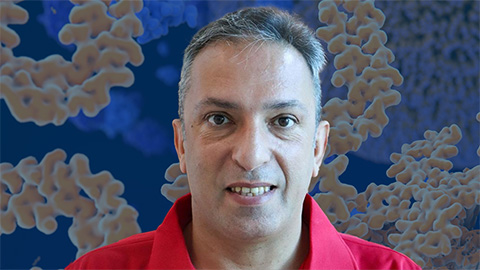Decoding organ communication systems
Like musicians in an orchestra, our organs perform highly specialized jobs yet depend on other organs to perform these jobs properly. To cooperate, organs must communicate using secreted proteins that travel through the blood. Ilia Droujinine is working to decode this communication system to understand how our organs work together to keep us healthy.

Droujinine has always enjoyed reading books about science and nature. While an undergraduate at the University of Waterloo, he completed several semester-long internships in labs around the world, studying neural stem cell migration at the University of Toronto, immune cell development at the Max Planck Institute for Immunobiology in Freiburg, Germany, and cancer biology at Brigham and Women's Hospital in Boston.
Equipped with a new appreciation for the power of experiments to reveal how living organisms work, Droujinine decided to pursue a Ph.D. at Harvard Medical School in Norbert Perrimon's group. His thesis research focused on long-distance communication between organs in the fruit fly Drosophila melanogaster.
The proteins that carry messages between organs are vastly outnumbered by other proteins in the blood such as hemoglobin. This makes them challenging to identify. Droujinine developed new tools to scan through all secreted proteins and find those that travel from one organ to another.
After completing his Ph.D., Droujinine moved to Scripps Research in California in October to start his own lab as a Scripps fellow and principal investigator. His lab will continue his work in the fruit fly and expand the tools he developed in mice to study how interorgan communication could apply to human health.
"I am very fortunate and thankful for this opportunity to develop my research program and grow into independence," Droujinine said.
When not in the lab, Droujinine enjoys reading science fiction and fantasy by such authors as Neil Stephenson and Brandon Sanderson and spending time with his wife and 3-year-old daughter.
Tracking messages between organs
Our organs send messages to each other by secreting proteins that travel through the blood. This communication system allows our organs to work together to support our health: Muscles can request more energy production from fat tissue, or wounded skin can tell the bone marrow to deploy immune cells.
These interorgan communication proteins can be hard to find, because they are surrounded by thousands of other proteins in the blood and carry little information about their origins or destinations.
Ilia Droujinine and his colleagues turned to the fruit fly Drosophila melanogaster, which shares organ systems and secreted proteins with humans, to look for interorgan communicators. They developed a large-scale tracking system to tag proteins in the fat body (similar to the human liver and adipose tissue) and the muscles. Their tracking system found hundreds of proteins made by these organs that traveled to other areas of the fruit fly body.
Many of these proteins have relatives in humans and could reveal new communication networks that help our organs work together. Droujinine and his colleagues plan to continue to investigate the functions of the secreted proteins they identified and to expand their tracking system to mammals.
Enjoy reading ASBMB Today?
Become a member to receive the print edition four times a year and the digital edition monthly.
Learn moreGet the latest from ASBMB Today
Enter your email address, and we’ll send you a weekly email with recent articles, interviews and more.
Latest in People
People highlights or most popular articles

Building the blueprint to block HIV
Wesley Sundquist will present his work on the HIV capsid and revolutionary drug, Lenacapavir, at the ASBMB Annual Meeting, March 7–10, in Maryland.

In memoriam: Alan G. Goodridge
He made pioneering discoveries on lipid metabolism and was an ASBMB member since 1971.

Alrubaye wins research and teaching awards
He was honored at the NACTA 2025 conference for the Educator Award and at the U of A State and National Awards reception for the Faculty Gold Medal.

Designing life’s building blocks with AI
Tanja Kortemme, a professor at the University of California, San Francisco, will discuss her research using computational biology to engineer proteins at the 2026 ASBMB Annual Meeting.

Jordahl named Gilliam Fellow
He will receive three years of funding to support his thesis research.

Bibel named assistant professor
She began her position at Loyola Marymount University in August 2025.

